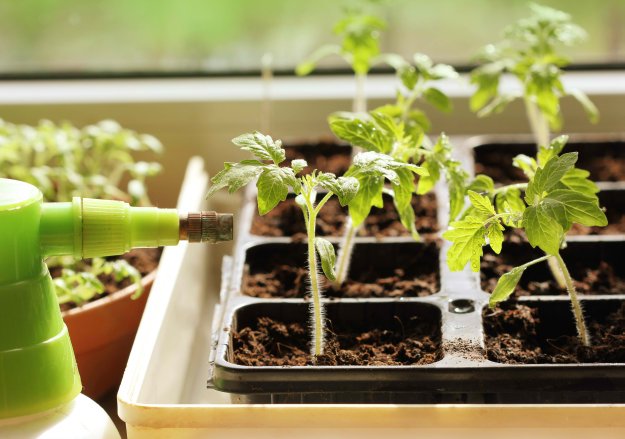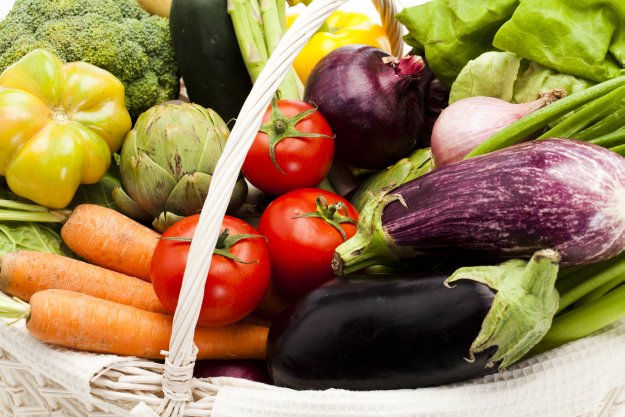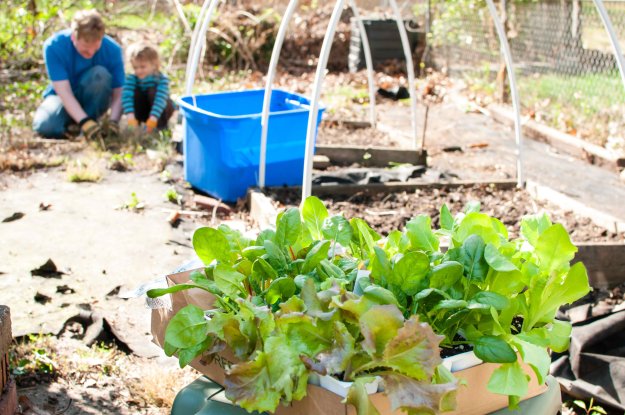Want to know when to plant a garden? Timing your garden just right is beneficial for growing the best vegetables each season. Get delicious seasonal vegetables on your homestead with these garden plans.
 You are reading Chapter 8 of our gardening series in The Homestead Handbook:
You are reading Chapter 8 of our gardening series in The Homestead Handbook:
How to Grow All The Food You Need In Your Own Backyard
CHAPTER 8:
When to Plant a Garden & Get the Most From All Seasons
Part of gardening is trying to squeeze the most out of the conditions Mother Nature gives you. It’s about a deeper understanding of what makes plants and fruit thrive, and using that understanding to make up for conditions that are less than ideal. In this chapter, we are going to discuss ways in which you can pull the best yield from your garden in all seasonal conditions. Imagine having fresh produce to contribute to the annual Thanksgiving dinner, or being the first in the neighborhood to have fresh fruit coming from your garden in the spring. These are just some of the benefits of trying to ‘extend your seasons’. This chapter will be organized by season for that purpose.

For most growers in the continental United States, the growing season is May to September with some small variation. This gives the average gardener only about half the year to have a productive garden. But what if you were able to extend this time by two months? That’s two more months of produce, fresh food for your family, and more yield to contribute to any canning or homesteading projects in the colder months. If you were a single-row gardener, the idea of lengthening your season would probably sound unattractive—you’d already be exhausted and fed up with all the extra work and overflow of single crop from your inefficient garden. But since you’re a square foot gardener, you’ve hopefully had a positive and exciting growing season that hasn’t worn you out a bit! For that reason, the idea of extending your season by two months is probably great news.
Extending the seasons aren’t necessary, and especially if this is your first time committing to a garden project, you might already feel plenty satisfied with your growing season. There’s no reason not to be satisfied and enjoy your half-year off, away from the garden. This chapter will be waiting for you in whatever season you do decide to extend!
One of the easiest ways to extend your growing season is, of course, to simply begin growing sooner in the year, and keep your garden going later into the fall. By using cool-weather crops in two extra plantings, this is certainly possible. Make your first planting in the early spring and you will see it maturing in late spring. The second crop, which should be planted in late summer, will then mature in the fall. Hot-weather crops can also be started two to three weeks earlier in the season, as well as extended a month into the fall.
Both early spring and late fall can bring some of the most extreme weather (again depending on your area of the country), so you should assume that you will need to protect these crops from the weather. Be prepared to do this before you commit to the extended season growing—you don’t want to be caught off-guard by a fast-moving thunderstorm, or worry about your crops from work because you didn’t plan ahead. Covering your crops and creating an artificial environment, much like a greenhouse, is the best solution to this problem. It gives your plant all the sunlight, holds in heat, and protects it from the ravaging effects of rain and wind.
One important thing to keep in mind when you’re trying to extend your seasons is that, ultimately, you are trying to do something against the natural instinct of your plants. They are designed to grow and die in very specific cycles, and what you’re doing is beyond that, so make sure you adjust your expectations accordingly. You probably are not going to get the same kind of crop yield as you do during the height of the season; you may find yourself pruning, watering, or protecting just a bit more than usual. You are trying to urge plants to keep growing after they are supposed to stop, so use this as a learning experience, but don’t get frustrated by a small yield! Let’s discuss each season individually.
Early spring is the most obvious choice when you’re thinking about extending your gardening season—you’re basically the “early bird” in your neighborhood, heading out after that worm while your neighbors are still in bed. To prepare your square foot garden for early planting, the first thing you’ll want to do is warm up the soil in your garden boxes. To do this, spread plastic over the soil. This can be found at your local hardware store and typically comes in either black or clear versions; neither is better for this task, so purchase according to your budget. Weigh down the plastic cover with a brick or rock in each corner. This will provide insulation over the soil as it soaks up the sunlight and traps the heat in. After a few days (as long as they’ve been mostly sunny), remove the plastic cover and your grid, then mix up the optimized soil with your trowel. This will bring up the soil from the bottom, which has probably received a lot less of the heat, up to the top. Then replace the cover and anchoring stones and allow the soil to sit under the sun for a few more days. Since your optimized soil is only 6 inches deep, this should be a relatively quick and easy process.
Early spring is also a great time to consider sprouting your seeds to get an early start on the season. Sprout them indoors and transplant them to individual containers while they are still young. Your square foot garden should be ready in time to receive them as transplants before they get too large.

Once spring is fully in swing, you’ll want to start your first planting. Set up a spring box with a storm window cover or other protective structure over the garden box and squares you plan on using to begin your early crop. This will help the sun warm the soil, and you’ll want to let this process happen for about four weeks before planting. Combining this cover with the plastic sheeting we just mentioned will double the warming time, but make sure to obviously remove the plastic sheeting before you plant. Once the weather is warm enough, you should be able to transplant your crops into the garden squares, where the soil will be warm and inviting for them.
Summer vegetables can also get a head-start. You can start the seeds for such popular summer crops such as cucumbers and beans under a protective cage in the garden about two weeks before their typical planting time. You will find these plants become very strong in comparison with the seeds sprouted inside or on your windowsill. You can remove the covers on these plants once there is no danger of a frost destroying them. There are a wide variety of covers you can use for this purpose, and we recommend you give a try to any that seem like they might work for your needs.
Another way to extend and protect your summer crops is the same way you protect yourself from the hot summer sun—shade and water! Plants wilt, much like people do, when they are getting overheated in the summer. As you become experienced as a gardener, you will be able to spot these wilting leaves very quickly and deal with them before the heat causes permanent damage to your crop. By giving these plants shade and a little extra water, it should prevent any drying out, and even extend your ability to harvest crops through the entirety of the summer season. A good rule of thumb is to water twice as often as you would in the spring to protect these summer crops, remembering that the optimized soil recipe will protect you from over watering.
Shade screens can be very important for your summer crops, because they won’t block out the light the plant needs to survive, but they will keep the long days of direct and harsh sunlight from scorching your plants and raising the soil temperatures. Your vertical garden, should you choose to build one, acts as a shade screen in and of itself—just one more reason to try one, if you were “on the fence” about it!
The late summer crops will need to be protected from that inevitable first fall frost. This is typically the point when these plants die off and your gardening season comes to an end. But with special care, you can extend the growth of these crops up to an extra three weeks, because often, you will experience clear weather after the first frost has fallen—the season doesn’t descend immediately frost and cold. Protect from this first frost, and you can usually ride out the calm end of the season with fresh produce after your neighbors have already given up their crops for the year.
To protect from frost, you can build a cover with a PVC arch and a large sheet of plastic or a light blanket. Make sure you anchor the corners of whatever cover you choose, or you may find yourself chasing the cover around the yard during a storm or strong wind. The same type of loose fabric can easily be thrown over the vertical garden frame, as well, which we recommend doing during the nights when frost is a potential problem.
The fall season signals the end, even for the extended-season gardener. You may have been able to get a few extra weeks out of your harvest if you followed this guide. Likely you are also at least passingly familiar with the various methods people use to make the most of their crop harvest, such as freezing or canning their extra fruits and veggies. Another method you can use is to actually store the harvest itself without canning or freezing. It’s a simple process, but does take specific requirements.
Each vegetable will have its own best conditions for storage, and you can use the internet to investigate those conditions depending on the crops you’re planting. Overall, however, there are only about two conditions you should expect to worry about: a cool, dry place, or a cold and moist place to store. It just depends on what vegetable needs which condition.

Cool and dry conditions are typical between 50-60 degrees Fahrenheit and with low humidity, below 50%. Check your garage, basement, or cellar for such conditions. Prevent any risk of the temperature dropping to freezing levels by providing some insulation—you can build enclosing walls to do so. In this area, you will want to spread your extra harvest out on a shelf—keep the veggies off the floor, and handle them as rarely as possible. When you must touch them, do so very gently! Any damage done to the veggie will increase its chance of spoiling. You can lay the veggies in newspaper or even sawdust, if available, as long as you do not pile the veggies on top of one another. You do not need to worry about washing the veggies first, or trimming off any roots or growth.
If your veggies need a cold and moist condition, which is typical of root crops (beets, potatoes, carrots, etc.) and fruit like apples, you want to keep them at a temperature just above freezing, in the range of 35-45 degrees Fahrenheit. The easiest way to accomplish these conditions is simply not to dig up these crops at all! Head to your local garden store or farm supply store, and purchase a bale of hay. You can put this over the planted area, breaking the tops of the plants to inhibit their growth during the winter. The hay will insulate the ground and keep it from freezing over, protecting the root crops beneath. Once you’re ready to harvest a few for a meal, just move the hay, harvest, and replace. Some of the crops will only last a few weeks even protected, where some like carrots can survive the entire winter. Don’t be afraid to experiment to see which crops do the best in your particular neck of the woods—you may be surprised what you discover survives! You can also replicate the hay method to protect leafy crops like lettuce, though you will want the hay to be loose and unwrapped rather than in a bale, as these crops are much more delicate aboveground. Place a tarp or plastic covering, or even a short fence of chicken wire, around this area of the garden to prevent the hay from blowing around your yard.
You can also keep your root crops safe by creating an artificial “burrow” for them. Bury a container like a plastic garbage can in the ground with a few inches above to prevent flooding. Place an insulating layer of hay—about 1 foot deep—over the top of your stored harvest before securing the top of the garbage can. Over the whole thing should be placed a tarp or plastic cover, and the container should be monitored regularly in case of flooding or groundwater leaks. Even a small leak will turn your harvest rotten quickly. For this reason, it is also very important that you make sure there is a secure lid on whatever type of container you choose to use for this method. The higher the ground you can select for this container, the better chance your harvest stands of surviving—higher ground is less likely to freeze in the winter.
Let’s talk about some of the issues that affect the health of your garden as the season winds down, particularly temperature and the appearance of frost. If you’ve spent a good deal of time walking around your yard in the evening or night, you’ve probably noticed that even in a small space of land that seems to be flat, there are temperature differences. Air moves around natural currents in your yard and is affected by the temperature of the ground, among other things. Once you’ve gotten an idea for how the temperature in your yard behaves, it will be much easier for you to plan your future garden positions. You can optimize your harvest by repositioning boxes and doing better planning on where to plant cold and hot crops, respectively.

Frost is one of the gardener’s ultimate foes. It is an unstoppable reality of nature, and while it is not as devastating as the weather conditions that can destroy homes, it is still powerful enough in its quiet appearance to destroy whole farms’ worth of crops. Frost appears when the temperature drops below freezing (32 degrees Fahrenheit). Once this temperature is breeched, the water in the air can freeze in tiny ice crystals that deposit on everything—cars, houses, windows, plants, grass, etc. Because air temperature is affected by air movement, it is not uncommon to see frost on low areas and none on high areas in the same yard—it simply depends on how cold the air was at each elevation. Hot air rises, so even just a slight temperature difference between a slope and a hilltop means the latter will probably end up frost-free while the former is covered in it. Frost typically forms in the early morning hours before sunrise, and typically when the weather has been calm. If a cold front has recently passed in your area, chances of frost understandably increase. The internet includes a wealth of resources that predict when the first frosts will occur in your area (though, like most weather prediction, it is not a perfect science). It will be good for you, as a gardener, to get in the habit of finding a reliable source of frost prediction and using it to be ready to make changes to your garden.
There are actually two different types of frost, and they affect your crops differently. The first kind, a “light frost”, can be damaging to plants but not necessarily kill them immediately. If your summer veggies receive a light frost, you will be able to tell by the dead outer leaves—and you will probably see it on the lawn, too, if you get up early enough in the morning. The veggies affected by a light frost can still be harvested, but you should eat them quickly. Plan on using them in that evening’s dinner so as not to waste them.
In contrast, a hard frost is much more deadly to your crops. It will kill your flowers and veggies outright. This is the kind of frost that crunches under your shoe when you walk on it. Typically, this is the frost that tells you your gardening season is truly over. You should be able to clean your garden from most of the frost if you still have flowers that do well in the fall, such as daises, and we encourage you to do so and get the most out of every day of your garden.
It may seem like we don’t even need a section on winter gardening, but this is for the truly ambitious gardener. It may not be the best choice for a beginner and does require some additional tools and set-up from your normal square foot garden set-up.
What can you grow in the winter, anyway? There are some types of leafy crops like lettuce, spinach, kale, and members of the onion family, that can survive in some winter conditions and give you a head start on your spring crop. Of course, you should treat this as a trial-and-error process. Depending on your area of the country, you may find more or less success with certain winter crops than advertised by the seed seller. Typically the companies will indicate on their packaging that a crop is “cold-tolerant” or meant for a winter garden. Sometimes you can even see it in the name, with added descriptions like “arctic”. Ask questions of your garden store specialist if you are unsure if a crop is appropriate for a winter garden.

The biggest issue with winter gardening is keeping the ground from freezing. This is a requirement even for winter crops. The best idea, then, when thinking about a winter garden, is to find yourself the area of the yard which gets the absolute most sunlight. This spot can be near the house or garage, and actually we encourage such a spot—the nearby walls will reflect light and heat onto the garden and protect it from chilling winds. Make sure your winter garden box is not underneath the gutter line of your roof; rain and snow may drip onto it and upset the temperature you’re trying to keep. The ideal spot for your winter garden is somewhat sheltered from the wind and gets as much winter sunlight as your yard can possibly provide.
First, you’ll want to lay down a sheet of landscaping fabric (or plastic sheeting) before you install your winter garden box. Setting it up after this point is exactly like your normal garden box, including the use of the optimized soil recipe. Keep in mind that winter crops are going to grow at a far slower rate than you’re used to with your normal garden, so patience is a virtue. Providing insulation around your winter garden box is highly recommended, and you can do so by building a wall of soil around the outside, building a small short wall, or using hay bales. A plastic cover will also prevent heat from escaping the air near the garden, and it’s easy for you to layer these covers and add more if the temperature drops to extremes.
We definitely recommend keeping a garden log book, a smart idea to update even when during the non-grow seasons. Your garden log should include a rough map and sketch of your yard, and where all your gardening features are placed. In this log, keep track of your gardening process. Make note of weeks you noticed the plants needed more water, or weeks where the temperature dropped lower than you expected. Keep a running track of where the sun hits in your yard and in what seasons. Track any issues or problems, and likewise the solutions you may have used to solve them. Write down observations about the health of your garden, or the appearance of pests, or the effectiveness of techniques. In this manner, you may discover patterns about your particular yard that will help you better conform your gardening plans, and give you the richest, most wonderful harvests from year to year.
When it’s time to fully close up your square foot garden for the year, do so with care and attention. After all, your gardens are home to living things that have—hopefully!—helped nourish your family and provided quite a bit of fun and beauty to your life. Taking care of it now also prevents more work later. A great first chore is to make sure the garden area is free of debris, leaves, old roots, and dead plants. Any of this you clean up can go straight to your compost pile. Speaking of compost, this is an ideal moment to add just a bit more of your homemade compost to the garden bed, making the area smooth in preparation for next year.
We recommend, if possible, removing your grids from your square foot gardens for the winter. They can be hung neatly and out of the way in another area of your home like the garage or basement. This will help you get the most possible years of life out of your grids, since they won’t be subjected to the elements during the cold season.
That was Chapter 8: When to Plant a Garden from our Homestead Handbook: How to Grow All The Food You Need In Your Own Backyard
Click Next to Read Chapter 9 >>
<< Click Here to go back to the Table of Contents

Leave a Reply